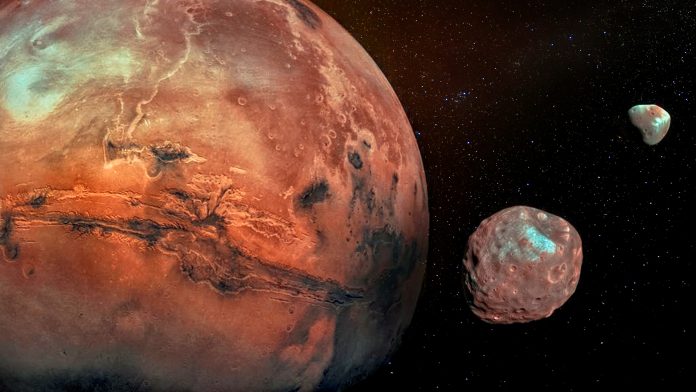In a first-of-its-kind study, a research team found that ancient bacteria could survive close to the surface of Mars for much longer than previously assumed.
The research, published in Astrobiology, also determined that because the bacteria are buried and shielded from galactic cosmic radiation and solar protons, they can survive for much longer.
The discovery of ancient bacteria strengthens the possibility that if life ever evolved on Mars, its biological remains might be revealed in future missions, such as ExoMars and the Mars Life Explorer. These missions will carry drills to extract materials from two metres below the surface.
Shattering previous survival records
The researchers simulated Mars’ harsh ionising radiation conditions to see how long dried frozen bacteria and fungi could survive. Previous studies had indicated that ancient bacteria could survive over one million years in Mars’ harsh environment.
However, this new study shatters the previous record, finding that this hearty bacterium could survive up to 280 million years if buried just below the surface. Therefore, this means that evidence of life could still be dormant and buried below Mars’ surface.
The team stated that scientists should be particularly observant of ancient sleeping bacteria when Mars’ first samples return to Earth.
Avoiding the crossover between Earth’s and Mars’ bacteria
Because the research has proved that certain strains of ancient bacteria can survive despite Mars’ harsh environment, future astronauts and space tourists could inadvertently contaminate Mars with bacteria brought from Earth.
“Our model organisms serve as proxies for both forward contamination of Mars, as well as backward contamination of Earth, both of which should be avoided,” said Michael Daly, Professor of Pathology at Uniformed Services University of the Health Sciences (USU) and member of the National Academies’ Committee on Planetary Protection.
“Importantly, these findings have biodefence implications too, because the threat of biological agents, such as Anthrax, remains a concern to military and homeland defence.”
Brian Hoffman, Professor of Chemistry and Molecular Biosciences at Northwestern University, stated: “We concluded that terrestrial contamination on Mars would essentially be permanent over timeframes of thousands of years.
“This could complicate scientific efforts to look for Martian life. Likewise, if microbes evolved on Mars, they could be capable of surviving until present day. That means returning Mars samples could contaminate Earth.”
Do these ancient bacteria prove that life could survive on Mars?
Conditions on Mars are arid and freezing, meaning that its environment is harsh and unforgiving. Moreover, temperatures average minus 80 degrees at mid-latitudes and it is constantly bombarded by intense galactic radiation and solar protons, meaning that the Red Planet seems inhospitable to life.
To assess whether or not life could survive in these conditions, the team determined the ionising radiation survival limits of microbial life. Then, they exposed six types of Earthling bacteria and fungi to a simulated Martian surface – which is frozen and dry – and zapped them with gamma rays to mimic radiation in space.
Hoffman explained: “There is no flowing water or significant water in the Martian atmosphere, so cells and spores would dry out. It also is known that the surface temperature on Mars is roughly similar to dry ice, so it is indeed deeply frozen.”
Ultimately, the team decided that some terrestrial microorganisms could potentially survive on Mars over hundreds of millions of years. Importantly, they discovered that one form of ancient bacteria, Deinococcus radiodurans, is particularly suited to surviving Mars’ harsh conditions. In novel experiments, these bacteria survived astronomical amounts of radiation in the freezing environment.
To test the effects of the microorganisms to radiation, the researchers exposed samples of ancient bacteria to gamma radiation and protons. Following this, they used an advanced spectroscopy technique to measure the accumulation of manganese antioxidants in the radiated bacteria’s cells. According to Hoffman, the size of the radiation dose that these ancient bacteria survive correlates with the number of manganese antioxidants it contains. Therefore, more manganese antioxidants mean more resistance to radiation, along with more enhanced survival.
In earlier studies, previous researchers found that when suspended in liquid, Deinococcus radiodurans can survive 25,000 units of radiation, the equivalent of about 1.2 million years just below Mars’ surface. But the new study found that when the hearty bacterium is dried, frozen, and deeply buried— which would be typical to a Martian environment — it could weather 140,000 units of radiation. This dose is 28,000 times greater than what would kill a human.
Although the ancient bacteria could only survive for a few hours at the surface while bathed in ultraviolet light, its lifetime improves dramatically when shaded or directly located below the surface of Mars. Buried just ten centimetres below the Martian surface, the bacteria’s survival period increases to 1.5 million years. Moreover, when buried ten metres down, the bacteria could survive a colossal 280 million years.
Looking to future missions
The astonishing survival of this ancient bacteria is partially down to its genetic structure, the researchers found. Although long suspected, they also discovered that the bacteria’s chromosomes and plasmids are linked together, keeping them in perfect alignment and ready for repair after intense radiation.
This means that if a microbe similar to the ancient bacteria evolved during a time when water last flowed on Mars, then its living remains could still be dormant in the deep subsurface.
Daly concluded: “Although Deinococcus radiodurans buried in the Martian subsurface could not survive dormant for the estimated 2 to 2.5 billion years since flowing water disappeared on Mars, such Martian environments are regularly altered and melted by meteorite impacts.
“We suggest that periodic melting could allow intermittent repopulation and dispersal. Also, if Martian life ever existed, even if viable lifeforms are not now present on Mars, their macromolecules and viruses would survive much longer. That strengthens the probability that, if life ever evolved on Mars, this will be revealed in future missions.”









